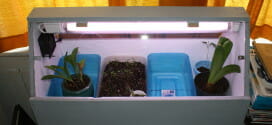Raspberries are delicious, versatile and easy to grow in the home garden. One of the best things about raspberies, besides eating them, is the fact that its a perennial plant that means you can plant them once and enjoy the fruits of your labor for years to come(pruning is needed). Follow this easy guide to growing raspberries and get started on the gardening road to growing berries.
Planting Location
Select a sunny location to start your raspberry patch. The site should receive at least 6 hours of direct sun each day.
Avoid low-lying areas where water drainage is poor and collect a soil sample to have tested at your local County Extension Office or garden supply center. Ideal soil pH for raspberry plants is 6.0 to 6.5. Add suggested soil ammendments and till the soil to the depth of 12 inches.
Raspberry Varieties
Raspberries comes in two varieties: erect and trailing. The erect bush variety will not need to be trained to grow on a trellis, but the trailing variety will need a trellis system. The trellis system needs to be installed before planting raspberry canes so the soil around them won’t be disturbed. More about building a trellis for raspberry plants later in the article.
When To Plant Raspberries
After the site has been selected and prepared, it’s time for planting raspberry canes. The ideal raspberry planting time is between December and March. Prepare the soil before it freezes in regions that have harsh winters and cover prepared soil with heavy mulch and a tarp.
How to Plant Raspberries
To plant raspberries, dig planting holes large enough to accommodate all the roots without bunching them up. Dig the holes 12 feet apart so each mature plant will have enough space and soil nutrients. Set the raspberry plant in the hole so the crown will be 1/2 inch below soil level. The crown is the origin of the root mass. When planting raspberries grown in a container, untangle the roots before setting them in the soil.
Some plants will have a piece of an old stem attached to the plant, this is called a ‘handle’ and should be above the soil surface.
Back-fill the hole with soil and water in each plant thoroughly. Add 4-6 inches of organic mulch (pine straw, wood bark chips, etc.) around the base of each plant, but don’t allow the mulch to touch the plant. Mulch helps retain soil moisture and prevents weed growth.
Building a Trellis
As mentioned previously, a trellis system should be built prior to planting raspberry canes if they are the trailing variety. Start by creating a line of fence posts using treated lumber that is about 6 feet tall. Growing berries will spread out and produce fruit for many years, so treated lumber is needed to prevent wood rot. Set posts in the ground 1 1/2 to 2 feet deep for stability and space them 10-20 feet apart in a straight row.
Use 9 gauge wire to create the growing pattern for the trailers that will grow from the raspberry plants. Start by attaching the first strand of wire 2 feet off the ground and stretching it along the length of the berry patch, connecting it to each post. Follow that with 2 more strands of wire spaced 18 inches apart.
The plants will be trained to grow along these strands of wire for easy care of berry harvesting.

Pruning and Training
Pruning isn’t needed the first year and only prune away the dying canes after the plant has produced its crop of berries the second season and every season thereafter.
Tie one new cane to in each side of the plant to the bottom wire of the trellis using flexible strips of fabric. Tie the fabric loosely to prevent it from cutting into the canes. As the raspberry plant grows, continue to tie the lateral growing canes to the second and top wires of the trellis. Prune away all growth below the first wire and all canes except the 3 on each side of the plant that are attached to the trellis wires.
Fertilize
Growing raspberry plants need to be fertilized twice a year: once in April and again in July. Scatter 2 ounces of granulated 10-10-10 fertilize on the soil around the base of each plant, being careful not to touch any part of the plant with the fertilize. Water the plants well after pruning and fertilizing.
Harvest Time
The reward of growing raspberries is getting to harvest and eat them at their peak. Berries are ready when they lose their high-gloss shine and turn slightly dull.


